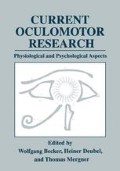Abstract
Why are psychiatrists interested in eye movements? Since the discovery of Diefendorf and Dodge in 1908 and the findings of Holzman and colleagues in 1974 it has been suggested that eye tracking dysfunction (ETD) may serve as a biological marker for schizophrenia in genetic linkage studies (Levinson et al. 1991). Already in those earlier studies a higher prevalence of ETD was found in both schizophrenic patients (50–86%) and their relatives (45%) when compared to normal subjects. ETD as a measurable indicator for vulnerability to schizophrenia may help to identify those individuals who carry the genetic trait without suffering from the disease (Grove et al. 1992).
Access this chapter
Tax calculation will be finalised at checkout
Purchases are for personal use only
Preview
Unable to display preview. Download preview PDF.
References
Abel LA, Friedman L, Jesberger JA, Malki A, Meltzer H Y (1991): Quantitative assessment of smooth pursuit gain and catch-up saccades in schizophrenia and affective disorders. Biol Psychiatry 29:1063–1072.
Arolt V, Lencer R, Nolte A, Müller-Myhsok B, Purmann S, Schürmann M, et al (1996): Eye tracking dysfunction is a putative phenotypic susceptibility marker of schizophrenia and maps to a locus on chromosome 6p in families with multiple occurrence of schizophrenia. Am J Med Gen 67:564–579.
Cegalis JA, Sweeny JA, Dellis EM (1982): Refixation saccades and attention in schizophrenia. J Psychiatry Res 7: 189–98
Clementz BA, McDowell JE, Zisock S (1994): Saccadic system functioning among schizophrenic patients and their first degree relatives. J Abnormal Psychology 103:277–87
Crawford TJ, Haeger B, Kennard C, Reveley MA, Henderson L (1995): Saccadic abnormalities in psychotic patients. Psychol Med 25:461–483
Diefendorf AR, Dodge R (1908). An experimental study of the ocular reactions on the insane from photographic records. Brain 31:451–489.
Fukushima J, Fukushima K, Chiba T, Tanaka S, Yamashita I, Kato M (1988): Disturbances of voluntary control of saccadic eye movements in schizophrenic patients. Biol Psychiatry 23:670–77
Grove WM, Clementz BA, Iacono WG, Katsanis J (1992): Smooth pursuit ocular motor dysfunction in schizophrenia: Evidence for a major gene. Am J Psychiatry 149:1362–1368.
Heide W, Kurzidim K, Kömpf D (1996): Deficits of smooth pursuit eye movements after frontal and parietal le-sions. Brain 119:1951–1969.
Holzman PS, Proctor LR, Levy DL, Yasillo NJ, Meltzer HY, Hurt SW (1974). Eye-tracking dysfunction in schizophrenic patients and their relatives. Arch Gen Psychiatry 31:143–151.
Iacono WG, Tuason VB, Johnson RA (1993): Dissociation of smooth pursuit and saccadic eye tracking in remitted schizophrenics. Arch Gen Psychiatry 38:991–96
Jürgens R, Kornhuber AW, Becker W (1987): Prediction and strategy in human smooth pursuit eye movements. In: Lüer G, Lass U, Shallo-Hoffmann J, editors. Eye movement research. Physiological and psychological aspects. Göttingen: CJ Hogrefe, pp 55–75.
Levin S, Holzman PS, Rothenberg SJ, Lipton RB (1981): Saccadic eye movements in psychotic patients. Psychiatry Res 5:47–58
Levin S (1984): Frontal lobe dysfunctions in schizophrenia- I. eye movement impairments. J Psychiatr Res 18:27–55.
Levinson DF, Mowry BJ (1991): Defining the schizophrenia spectrum: Issues for genetic linkage studies. Schizophr Bull 17:491–514.
Mackert A, Flechtner M (1989): Saccadic reaction times in acute and remitted schizophrenics. Euro Arch Psychia-tty Neurol Sci 239:33–38.
Mackert A, Flechtner M, Frick K (1989): Reaktionszeiten und visopatiale Aufmerksamkeitsstörung bei Schizophrenen mit Negativsymptomatik. Fortschr Neurol Psychiat 57:535–43
Matsue Y, Saito H, Osakabe K (1994): Smooth pursuit eye movement and voluntary control of saccades in the antisaccade task in schizophrenic patients. Jpn J Psychiatry Neurol 48:13–22
Moser A, Kömpf D, Arolt V, Resch T (1990): Quantitative analysis of eye movements in schizophrenia. Neuroo-phthalmology 10:73–80
Radant AD, Hommer DW (1992): A quantitative analysis of saccades and smooth pursuit during visual pursuit tracking. A comparison of schizophrenics with normals and substance abusing controls. Schizophr Res 6:225–235.
Schmid-Burgk W, Becker W, Jürgens R, Kornhuber HH (1983): Saccadic eye movements in psychiatric patients. Neuropsychobiology 10:193–98
Schmid-Burgk W, Becker W, Diekmann V, Jürgens R, Kornhuber HH (1982): Disturbed smooth pursuit and saccadic eye movement in schizophrenia. Arch Psychiat Nervenkr 323:381–89
Schreiber H, Rothmeier J, Becker W, Jürgens R, Born J, Stolz-Born H, Westphal KP, Kornhuber HH (1995): Comparative assessment of saccadic eye movements, psychomotor and cognitive performance in schizophrenics, their first-degree relatives and control subjects. Acta Psychiatr Scand 91: 195–201
Schoepf D, Heide W, Arolt V, Junghanns K, Kömpf D (1995): Deficits of smooth pursuit initiation in schizophrenic patients. Soc Neurosci 21:922.
Sereno AB, Holzman PS (1995): Antisaccades and smooth pursuit eye movements in schizophrenics. Biol Psychiatry 37:394–401
Trillenberg P, Heide W, Junghanns K, Blankenburg M, Arolt V, Kömpf D (accepted 10/1997): Target anticipation and impairment of smooth pursuit eye movements in schizophrenia. Exp Brain Res., in press
Author information
Authors and Affiliations
Editor information
Editors and Affiliations
Rights and permissions
Copyright information
© 1999 Springer Science+Business Media New York
About this chapter
Cite this chapter
Lencer, R., Krecker, K., Malchow, C.P., Nolte, A., Arolt, V. (1999). A Comparison of Eye Movements in Families with Multiple Occurrence of Schizophrenia and Normal Families. In: Becker, W., Deubel, H., Mergner, T. (eds) Current Oculomotor Research. Springer, Boston, MA. https://doi.org/10.1007/978-1-4757-3054-8_59
Download citation
DOI: https://doi.org/10.1007/978-1-4757-3054-8_59
Publisher Name: Springer, Boston, MA
Print ISBN: 978-1-4419-3308-9
Online ISBN: 978-1-4757-3054-8
eBook Packages: Springer Book Archive

